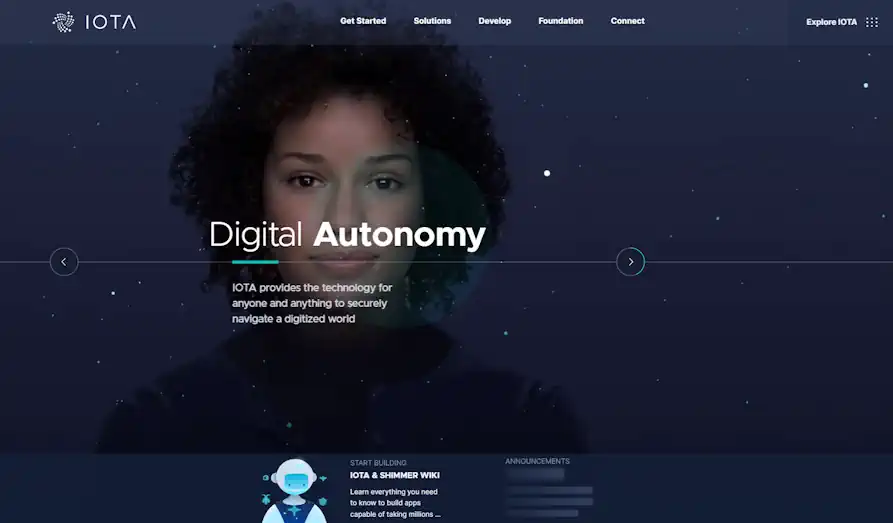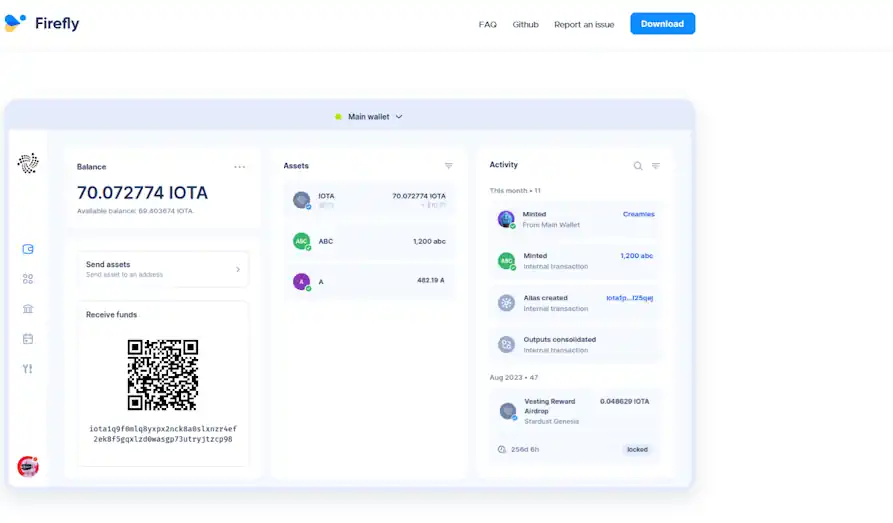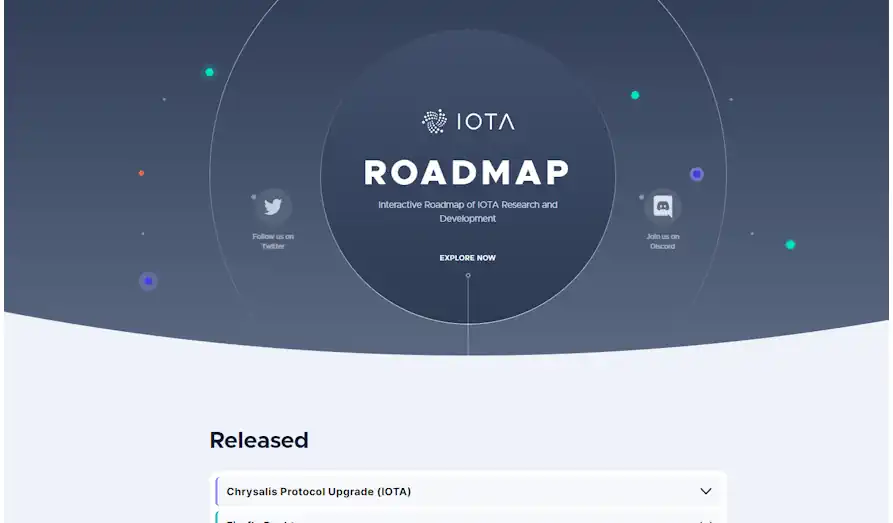


IOTA is a distributed ledger with a focus on the Internet of Things to help power microtransactions between internet-connected devices. It uses the Tangle system, which uses a consensus algorithm to validate transactions. Here, the sender must validate two other transactions before they can complete their own.
The system eliminates the need for validators and miners, which effectively eliminates the costs associated with the said transactions. This smart contract-enabled blockchain also allows the transfer of non-monetary data between devices, a key feature in powering secure communications between IoT devices. The idea was well received in the industry, and different players have already collaborated with IOTA to power different solutions.
A Bit About IOTA
IOTA can be described as a feeless value transfer protocol. It enables speedy value and data transfers without charging a dime. The creators of the project sought to deal with inefficiencies in blockchains as well as related costs. Besides, it wishes to provide secure data transfers between devices without requiring high computing power, as is the case with traditional blockchains.
Three entrepreneurs in Berlin, Germany, formed IOTA. They include data scientists and a money-market expert. The team has been improving the solution to enable various disciplines around the world to adapt it for different solutions.
IOTA is a distributed ledger designed to power microtransactions among Internet of Things devices. The IOTA Foundation likens it to the connective tissue in the human body, but in this case, it allows interoperability between machine and human economies. The blockchain enables companies to monetize the fees they get from IOTA. This way, they get value for their efforts.
The smart contract network can handle payments as well as non-monetary transactions between two or more devices connected to the internet. IOTA is the native token that facilitates these transactions.
This network uses a proprietary blockchain called Tangle. It is a consensus algorithm where users are required to validate two transactions before they can complete their own. The direct acyclic graph (DAG) consensus eliminates validators, miners, blocks, and transaction fees. With these players removed, there are no scalability or cost issues on the network.
Utility of IOTA?
IOTA is a system that powers microtransactions. It can be used in different disciplines to meet varying goals. Some of these disciplines include the Internet of Things, eHealth, mobility and the automotive industry, manufacturing and supply chains, and smart energy.
In all these industries, it enables decentralization, secure communications, and traceability. Industries that use mechanized systems extensively can harvest the data effectively while rewarding participants with IOTA coin.
Holders of the coin have various benefits. First, they are able to enjoy all the features of the network, as they are able to pay for them. Second, they can adapt the blockchain to their needs. This is especially true for companies and solution-givers. Users can also pay for services and products at outlets that accept IOTA coin or Shimmer. If the value of the coin goes up, they also stand to earn more.
IOTA Price details
›› IOTA tokenomics and social media
Advantages of IOTA
 + There are no transaction fees, like in Ethereum, or rewards for miners, like in Bitcoin.
+ There are no transaction fees, like in Ethereum, or rewards for miners, like in Bitcoin.+ IOTA handles over 1,000 transactions per second, ensuring fast transactions.
+ The blockchain is designed to allow operation in a low-energy environment.
+ No need for validators, as IOTA runs a fee-free data and value transfer protocol.
+ IOTA's blockchain lacks roadmap transparency, which creates trust issues.
Disadvantages
- IOTA has not achieved as much adoption as leading blockchains such as Ethereum.
- Every node must verify two previous transactions before confirming their own.
- The blockchain’s tangle network requires more activity for faster authentication.
- IOTA's groundbreaking solutions have not been extensively used across industries.
Costs
▪ Rated at 10/10There are no costs associated with transacting on the IOTA network. This is the unique feature of the network and its biggest selling point. There are no gas fees, as there are no validators or miners that need to be rewarded for completing specific tasks. Therefore, you can move as much as you wish without paying a dime for it.
Reputation and Buzz
▪ Reputation rated at 9.5/10▪ Buzz rated at 8/10
Despite this being a unique idea with solutions better suited for different companies than utility activities, the blockchain has received positive word from players across various disciplines. Many believe that it is the network of the future, and its use will become more pronounced once the Internet of Things becomes a household technology.
Industry leaders in the automotive, health, and computing disciplines have openly received it, and some have already integrated it into their systems. Currently, the IOTA Foundation has over 270k followers on Twitter and 64,000 on Discord. It has also received airplay on major cryptocurrency forums over the years. We expect the numbers to grow as many people continue to adopt the Internet of Things for various activities.
FAQ
What is Tangle?
Tangle is essentially a direct acyclic graph (DAG) consensus algorithm. Its structure requires users to validate two transactions before completing their own. This helps eliminate validators, miners, and other nodes that may need rewards. Besides, it requires low computing power, which enables just any IoT device to perform the transactions.
How do you buy IOTA?
You can buy IOTA, the project's native coin, on various crypto exchanges, including Bitfinex, Binance, and more. The process involves registering for an account and being verified. Then, set up a crypto wallet that accepts IOTA. There are several crypto wallets on the market, including Firefly, which is offered by the IOTA Foundation. From here, you can just deposit cryptocurrency or fiat money to buy the coins.
History of IOTA
May 2015 - IOTA was formed in Berlin, Germany, by a team of three entrepreneurs, among them Professor Serguei Popov and Dominik Schiener. They were looking to do away with the costs that come with blockchain transactions and enable easier scaling of transactions.
November 2015 - The token is launched in a sale beginning on the 15th of the month.
February 2017 – The establishment of the IOTA Foundation to oversee the research, development, and standardization of IOTA as well as the Internet of Things
April 2019 – IOTA gets into partnership with Jaguar Land Rover. The carmaker rewards car owners with IOTA coin for reporting data to it.
October 2019 – IOTA collaborates with the Linux Foundation and Dell. They work on a project called Alvarium to help validate the data being sold. It will be able to rate how trustworthy the data is.
April 2023 - IOTA starts the ShimmerEVM test chain to enhance the interoperability of EVM-compatible smart contracts.
Screenshots from IOTA
More sites where to buy/sell/trade IOTA
Below you can see some other platforms, exchanges and/or brokers where you can buy, sell or trade this coin. Click on the logo to read our review.Never speculate with money which you can not afford to loose. Cryptocurrencies exhibit significant volatility and remain largely unregulated within numerous European Union nations. They are not covered by European Union protections and do not fall under the purview of the EU's regulatory framework. Please be aware that investments in this sector are prone to market risks, which may include the total loss of the invested principal.













































